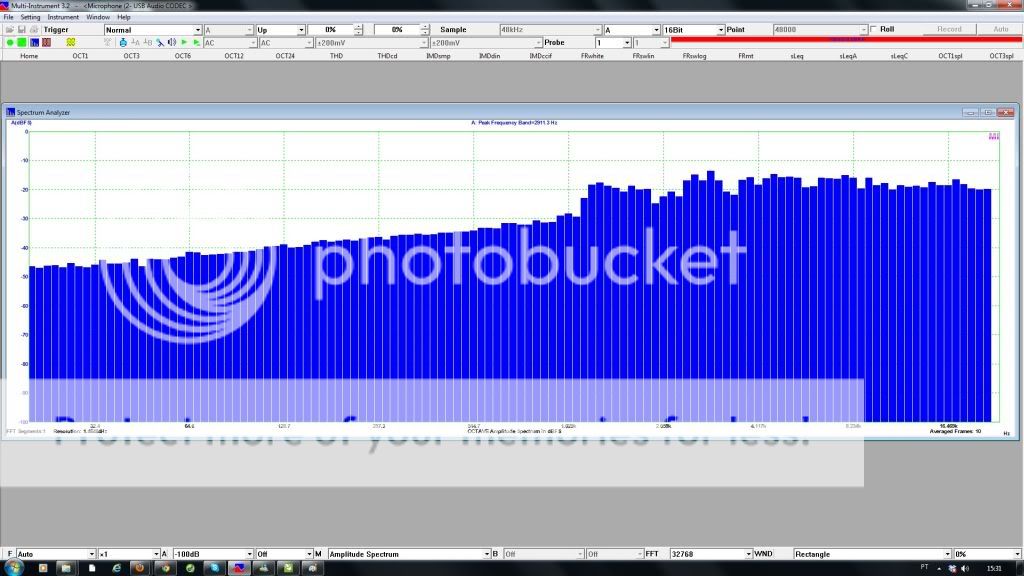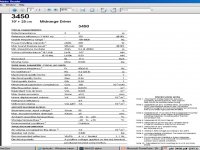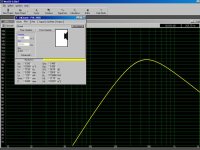I found T/S specs for the PHL 3450 which are reported to be very smilar to the 3451. As you can see from the Winisd plot, the high Fs and low Qts generate a -3db of 240Hz in a sealed box. Some would consider this too high, but it is the natural result of a high efficiency 99db/watt speaker design.
SO,
A 10" midbass looks like the best diameter for the TPL150H horn directivity blending.
A very high efficiency 10" like the PHL 3451 will result in a high(240Hz) bass crossover point if a sealed box with normal Qts = 0.707 is used.
A 10" with ~94db/watt efficiency would normally have T/S parameters that produce a -3db around 80-100Hz in a QB3 sealed box.
High efficiency bass can require one, and sometimes two, 15"-21" woofers in a big cabinet. If you work out the maximum volume bass cabinet you want in your room, it might help you decide upon the midbass + TPL150H efficiency point. A 99db/watt midbass and tweeter would just get padded down if the bass box size limits total efficiency to 94db/watt.
SO,
A 10" midbass looks like the best diameter for the TPL150H horn directivity blending.
A very high efficiency 10" like the PHL 3451 will result in a high(240Hz) bass crossover point if a sealed box with normal Qts = 0.707 is used.
A 10" with ~94db/watt efficiency would normally have T/S parameters that produce a -3db around 80-100Hz in a QB3 sealed box.
High efficiency bass can require one, and sometimes two, 15"-21" woofers in a big cabinet. If you work out the maximum volume bass cabinet you want in your room, it might help you decide upon the midbass + TPL150H efficiency point. A 99db/watt midbass and tweeter would just get padded down if the bass box size limits total efficiency to 94db/watt.
Attachments
midrange for beyma tpl150h
Hi
i am very interested in your project as i am looking for a beyma tpl150h kit also . you might be aware about the drivers that are used by aschenbach and eckhorn , they both prefer pairing it w/ 10" driver, both use a mtm configuration
here are two links:
it is called hornet evo which uses two beyma 10g40
Hornet by Michael Weides
and the aschenbach son-xl version which uses phl drivers .
SON-XL
the miles is using two 15" beyma. i like the high sensitivity and do not mind the size.
i am a little skeptical how it matches the tpl but everything i read sounds very promising .
here is a guy building them:
My latest and largest HE speaker build
i am wondering if there are more documented builds for more information and i am looking forward to see what your experience will be .
regards
malcolm
Hi
i am very interested in your project as i am looking for a beyma tpl150h kit also . you might be aware about the drivers that are used by aschenbach and eckhorn , they both prefer pairing it w/ 10" driver, both use a mtm configuration
here are two links:
it is called hornet evo which uses two beyma 10g40
Hornet by Michael Weides
and the aschenbach son-xl version which uses phl drivers .
SON-XL
the miles is using two 15" beyma. i like the high sensitivity and do not mind the size.
i am a little skeptical how it matches the tpl but everything i read sounds very promising .
here is a guy building them:
My latest and largest HE speaker build
i am wondering if there are more documented builds for more information and i am looking forward to see what your experience will be .
regards
malcolm
You'll need to get involved in the breakup region if you are to cross to a tweeter with narrow dispersion, and with measurements at multiple angles you'll be able to navigate this region both to avoid problems and to match the drivers. A 15" driver can be used this high. You will need to be careful as you are running it close to problems but this doesn't mean it can't be done well. In fact if you were to use a smaller driver you'll have the exact same issues, ie: a strictly limited ideal range to cross somewhere toward the breakup region, the limits of the driver, a higher frequency for the smaller driver and thus just as much an issue only it is closer to our more sensitive hearing range so is it better at all? The limitation of course is your waveguide capability. If it can't go low, you can't use a large woofer...and by low, I mean without losing its dispersion pattern.I've been told that the TD15M, due to the shape of the cone and the phase plug, this increases its dispersion caracteristics some 10%. As I'm aming for a 1200Hz x-over,
I'm with kipman725 on this. If you can tell the weight of the cone by listening I'd suggest you're not using the driver correctly.Can a 0.02g Mms ribbon tweeter "perfectly blend" at 1,200Hz with a 70g Mms TD15M midbass?
We all may want this quality of timbre...a crossover may change the directivity index and two drivers may not match well at that point but these would be design faults, not a good reason to avoid crossing. It is the same as the old school amateur justification for using full range drivers in inappropriate ways.My ears like the coherence and common timbre achieved from keeping the vocal range on one driver. To stay under lambda/4 C-C spacing would likely require a 4-way design
How does that work? I've been wondering how to do that for my project. Is there a link or thread you can point to that gives a good explanation of how to do that?... I normally mount my midbass and tweeter onto a junk refrigerator cardboard box and perform a few measurements, including using square waves to measure the time delay between the two drivers at the crossover frequency.
Member
Joined 2009
Paid Member
Thanks - good link!
Thanks - good link!
i am very curious what his findings will be as he has paired the tpl150h w/ beyma 15P80Nd like the inConcert Miles w/ low xover point for the tpl and really likes the result , but now he is implementing a 10" driver .
so i am watching closely what his next findings will be .
Last edited:
i am very curious what his findings will be as he has paired the tpl150h w/ beyma 15P80Nd like the inConcert Miles w/ low xover point for the tpl and really likes the result , but now he is implementing a 10" driver .
so i am watching closely what his next findings will be .
Maybe he to decided to measure the Beyma insted of blindly believing manufacturer specs
I guess 800Hz x-over is with tail wind, down hill and sun in the back
Do you have a link?
Maybe he to decided to measure the Beyma insted of blindly believing manufacturer specs
I guess 800Hz x-over is with tail wind, down hill and sun in the back
Do you have a link?
i agree .i am doubting those numbers myself , just reporting what some people say they are using , i think the inconcert miles is crossed at 900hz , not that that is much different.
are you asking for a link for measurements or the project where someone used the drivers at 900hz xover ?
hum4god:
No, I'm stupid. I just thought it was Stig who rebuilt the Miles, since he had found out that the Beyma didn't comply to the 800Hz x-over.
Still, 900Hz in the stock H-horn is a no, no!
If You've seen my posts with mesurements on the horn its quite obvious that 900Hz is no!
Hmm, maybe I'll glue a trial horn together this weekend and stuck a microphone down its throat
No, I'm stupid. I just thought it was Stig who rebuilt the Miles, since he had found out that the Beyma didn't comply to the 800Hz x-over.
Still, 900Hz in the stock H-horn is a no, no!
If You've seen my posts with mesurements on the horn its quite obvious that 900Hz is no!
Hmm, maybe I'll glue a trial horn together this weekend and stuck a microphone down its throat
I found T/S specs for the PHL 3450 which are reported to be very smilar to the 3451. As you can see from the Winisd plot, the high Fs and low Qts generate a -3db of 240Hz in a sealed box. Some would consider this too high, but it is the natural result of a high efficiency 99db/watt speaker design.
SO,
A 10" midbass looks like the best diameter for the TPL150H horn directivity blending.
A very high efficiency 10" like the PHL 3451 will result in a high(240Hz) bass crossover point if a sealed box with normal Qts = 0.707 is used.
A 10" with ~94db/watt efficiency would normally have T/S parameters that produce a -3db around 80-100Hz in a QB3 sealed box.
High efficiency bass can require one, and sometimes two, 15"-21" woofers in a big cabinet. If you work out the maximum volume bass cabinet you want in your room, it might help you decide upon the midbass + TPL150H efficiency point. A 99db/watt midbass and tweeter would just get padded down if the bass box size limits total efficiency to 94db/watt.
The PHL 3451 is a little different, which makes it go to 200Hz, closed box
I'm opting for a full active system, so efficiency issues are secondary, if minor (+-3dB)
Crossing the Beyma at 1200-1500Hz is more optimistic!
?
1,2khz is about the lowest the TPL-150 can be crossed in a wave guide :
AV Eikon : finished - Page 3 - Audio Voice Acoustics
Beyma TPL-150 with wave guide:
measured at 1m distance.

Angelo:
I envy you, looking at your system
Fane Studio 8M bass/Mid horn? ...crossed to...?
Where does the Beyma fit in?
The Fane Studio 8M is crossed at 1,2khz ( where the Beyma starts ) The midrange horn above the Beyma ( with Coral M100 compression driver ) works parallel to the Beyma , crossed also at 1,2khz, first order, but strongly attenuated with LPad. The TPL-150 has not so good vertical dispersion, so that channel helps out a littlebit.
You can see the measurements of the other channels here:
http://www.audiovoice-acoustics.com/forum/showthread.php?t=405&page=2
Probably soon i will give a try, and replace the Fane Studio 8M with LineMagnetic 555 field coil compression driver ( i have become official distributor of LineMagnetic for Latin america
Angelo
Last edited:
Member
Joined 2009
Paid Member
i am very curious what his findings will be as he has paired the tpl150h w/ beyma 15P80Nd like the inConcert Miles w/ low xover point for the tpl and really likes the result , but now he is implementing a 10" driver .
so i am watching closely what his next findings will be .
I discovered last night that he got into a pissy exchange with others on a different thread and has left that forum - we may never find out what his findings are.
The Fane Studio 8M is crossed at 1,2khz ( where the Beyma starts ) The midrange horn above the Beyma ( with Coral M100 compression driver ) works parallel to the Beyma , crossed also at 1,2khz, first order, but strongly attenuated with LPad. The TPL-150 has not so good vertical dispersion, so that channel helps out a littlebit.
Angelo
Regarding the vertical dispersion (Beyma). Why not just stack two beymas, problem solved
Regarding the vertical dispersion (Beyma). Why not just stack two beymas, problem solved
Absolutely. I thought already about this. That would be a viable solution. Since my system was a concept previous to the Beyma, configuration remains the way it is , and problem is solved as well :=)
Did some rough Beyma measurements on a 80x30 horn, axial depth 200mm.
I would have hoped for more low end, looks like approx. -3dB (-4dB) at 1000Hz
do you have any pics of such a horn?
do you have any pics of such a horn?
Mayhaps I can locate it my scrapyard, its build of leftovers = non-thrilling looks
- Status
- This old topic is closed. If you want to reopen this topic, contact a moderator using the "Report Post" button.
- Home
- Loudspeakers
- Multi-Way
- large format midrange driver or...




